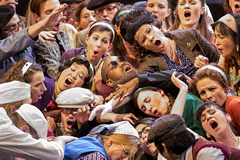| Opera Reviews | 19 April 2024 |
Operatic blissby Moore Parker |
|
| Rossini: Le Comte Ory Theater an der Wien 27 February 2013 |
|
|
It's team of directors, Moshe Leiser and Patrice Caurier are evidently blessed with the taste, technique and intent to serve a work and its composer (last year's Salzburg Gulio Cesare also springs to mind) - whereby gesture and action dovetail with the score to produce a Gesamtkunstwerk filled with imagination and true entertainment value. Christian Fenouillat (Sets), Christoph Forey (Lighting), and Agostino Cavalca (Costumes) also participated in the Salzburg success. They are evidently a winning team. The 20 century setting exposes a charming village for Act 1, spread over two vertical levels and extending into the horizon. With the local male population away at war, Count Ory (aided by his friend Raimbaud) plots to take advantage of the abstinent female population under the guise of a religious hermit. His "abode" is a souped-up 1950's camping caravan which serves for the ensuing orgy with the locals, before its walls and roof fold back to reveal an interior den, decorated in red glitz and leopard-skin-benches and primed for the seduction of Countess Adele (Cecilia Bartoli) who has just arrived in a Citroen 2CV. In his final argument to persuade Adele to relinquish her vows of self-imposed chastity, the would-be mentor (Ory, alias Hermit) reveals his ace card - a huge banner across the caravan's rear, stating "Dieu est Amour"! Unfortunately for Ory, Adele uses her newfound freedom to turn her attentions to the young soldier, Isolier - who is in fact Ory's Page. And so the farce unfolds, filled with hilarious touches and minute detail which continue through Act 2. Adele and her entourage sip tea in her salon as a storm breaks. Now disguised as nuns, Ory and his companions pretend to seek refuge at Adele's with the true intent of pursuing their libidinous ambitions. The weather conditions bring down the crucifix from its hook on the wall, explode electric bulbs in the chandelier, and the frivolity mounts as the "nuns" empty a pair of crates from the wine cellar before retiring to their quarters. Ory returns, to make unwitting advances to Isolier, who is now is disguised as Adele. When a fanfare announces the end of war and return of the village menfolk, Ory has no choice but to admit defeat and begs Adele for forgiveness. There really isn't a dull moment in the evening, and oodles of opportunity for the cast to test their mettle as singing-actors. In the title role, Lawrence Brownlee is delightful as the lascivious blind hermit, ridiculously padded around his midriff and sporting a white cane and dark glasses. He is even more amusing in the nun's habit, leading his spirited band of conspirators with aplomb. Brownlee's tenore di grazia is unusually rich in texture, yet manages Ory's testing lines with accuracy and bravura. Absent from the initial performances due to indisposition, Cecilia Bartoli wins through her sheer verve and infectious sense of fun. The occasional passage appeared slightly tenuous in her opening scene, but she blossomed vocally as the evening progressed and really found form in two of the musical highlights of the evening; the Act 2 duet with Liliana Nikiteanu (an imposingly fruity-toned Ragonde, and Bartoli's forthcoming Adalgisa in Norma later this year in Salzburg), and in the charming Act 3 trio with Ory and Isolier (pertly portrayed here by the young soprano Regula Muehlemann). Pietro Spagnoli enjoyed a field day with Raimbaud. The role is right in his Fach, and an ideal foil to Ory and Adele. Peter Kalman is a characterful tutor, well-negotiating the preparation of his packed lunch with penknife, baguette and tin of pâté de fois gras while balancing his bottle of red wine. The more minor roles were placed in the competent hands of members of the Wiener Kammer Oper ensemble, who together with an exceptional contribution by the Arnold Schoenberg Chor brought each and every character to life. The aural side of the proceedings was on a par with the ocular, with Jean-Christophe Spinosi uniting stage and pit in a meticulous and effervescent reading. Le Comte Ory's association with Il Viaggio a Reims doesn't begin and end with its conception back in the 1820's - through good fortune both works have enjoyed memorable presentations here in the Austrian capital. This latest Theater an der Wien jewel joins the legendary 1988 Staatsoper Viaggio on the list of local operatic treasures. |
|
| Text ©
Moore Parker Photo © Werner Kmetitsch / PhotoWerK |

 From
the first chord of the overture to the encore (initiated with apparent
spontaneity by Cecilia Bartoli after the first round of curtain calls),
this production epitomized operatic bliss.
From
the first chord of the overture to the encore (initiated with apparent
spontaneity by Cecilia Bartoli after the first round of curtain calls),
this production epitomized operatic bliss.





